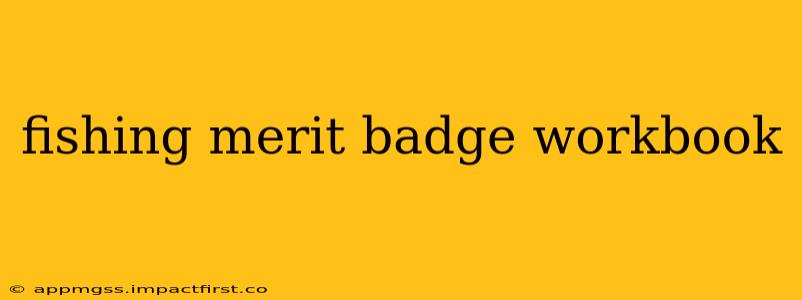Earning the Fishing merit badge is a rewarding experience, teaching valuable outdoor skills and fostering an appreciation for conservation. This comprehensive guide serves as your workbook, helping you navigate the requirements and gain a deeper understanding of fishing. We'll cover everything from knot-tying to fish identification, ensuring you're well-prepared for your merit badge counselor's review.
What are the Requirements for the Fishing Merit Badge?
Before we dive into the specifics, let's outline the requirements for the Fishing merit badge. These requirements, as set by the Boy Scouts of America, form the framework for your learning journey. Remember to consult the official merit badge pamphlet for the most up-to-date information and any potential revisions. Generally, the requirements revolve around:
- Safety: Understanding fishing safety practices is paramount.
- Equipment: You'll need to familiarize yourself with different types of fishing equipment.
- Techniques: Mastering various fishing techniques is essential for success.
- Conservation: Responsible fishing practices and conservation are key aspects.
- Fish Identification: Learning to identify common fish species is a crucial requirement.
How to Choose the Right Fishing Gear: Rods, Reels, and Lines
Selecting the appropriate fishing gear depends heavily on the type of fish you're targeting and the environment you'll be fishing in. Let's break down the essentials:
-
Rods: Consider the length, action (how much it bends), and material (graphite, fiberglass, etc.). A longer rod offers better casting distance, while a shorter rod is more manageable in tight spaces. The action determines how the rod bends under pressure.
-
Reels: Spinning reels and baitcasting reels are the most common types. Spinning reels are generally easier to learn, while baitcasting reels offer more control and casting distance for experienced anglers. Consider the reel's size and drag system (which controls the tension on the line).
-
Lines: Line strength (measured in pounds test) and type (monofilament, braided, fluorocarbon) are crucial considerations. Heavier lines are better for larger fish, while lighter lines are more sensitive. Different line types have varying strengths and visibility in water.
What are the Basic Fishing Knots Every Angler Should Know?
Knot-tying is a fundamental skill for any angler. Weak knots lead to lost fish and frustrating fishing trips. Here are some essential knots:
- Improved Clinch Knot: This is a widely used knot for attaching a hook or lure to your fishing line.
- Palomar Knot: A strong and reliable knot, often preferred for its simplicity and strength.
- Blood Knot: Used to join two lines of equal diameter.
How Do I Tie These Knots Properly?
Detailed instructions and diagrams for these knots are readily available online and in numerous fishing guides. Practicing these knots until you can tie them quickly and efficiently is crucial. Your merit badge counselor can help you perfect your knot-tying skills.
What are Some Popular Fishing Techniques?
Different techniques are suited for various fish and environments. Here are a few popular methods:
- Bait Fishing: Using live bait or artificial bait to attract and hook fish.
- Spin Casting: Casting lures with a spinning reel.
- Fly Fishing: A more specialized technique using artificial flies to imitate insects.
Which Fishing Techniques are Best for Beginners?
Bait fishing is generally considered the easiest technique for beginners. It's straightforward and effective for catching a variety of fish.
What are the Ethical and Responsible Fishing Practices?
Responsible angling is crucial for conserving fish populations and protecting the environment. Key aspects include:
- Catch and Release: Practicing catch and release for certain species helps maintain healthy populations.
- Using Barbless Hooks: Barbless hooks minimize injury to fish during catch and release.
- Respecting Fishing Regulations: Adhering to size and bag limits is essential for sustainable fishing.
How Do I Practice Catch and Release Properly?
Handle fish carefully, keep them in the water as much as possible, and use appropriate tools to remove hooks quickly.
How to Identify Common Fish Species in My Area
Identifying fish is a vital part of the merit badge. Learn to identify common species in your local waters. This may involve:
- Using a Field Guide: Consult regional fish identification guides.
- Observing Physical Characteristics: Pay attention to fish shape, color, fin patterns, and other distinguishing features.
- Consulting Local Experts: Seek advice from experienced anglers or fisheries biologists.
What are Some Resources for Identifying Fish?
Your local fish and wildlife agency's website is an excellent resource for identifying fish in your region.
Conclusion: Mastering the Art of Fishing
Earning the Fishing merit badge is a journey of learning and discovery. By mastering the skills and understanding the principles outlined in this workbook, you’ll be well on your way to becoming a responsible and knowledgeable angler. Remember to always prioritize safety and conservation, and enjoy the rewarding experience of connecting with nature through fishing. Good luck!
